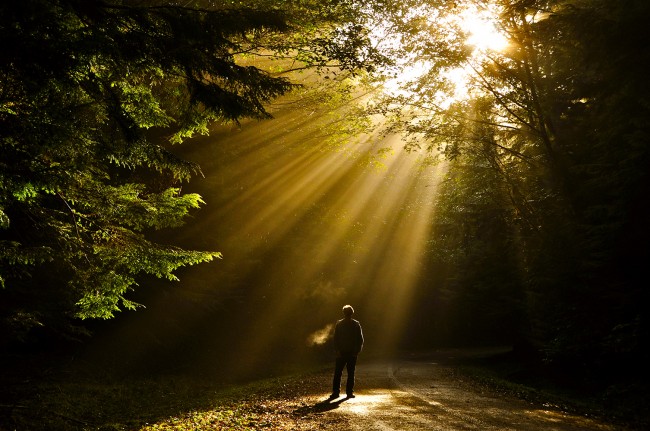
Photo Credit: Guy Kimola
Eternal Spaces
Eternal Spaces by Britta Boudreau The silence is penetrating. I am walking down Cemetery Road on the mist-shrouded archipelago of Haida Gwaii, surrounded by Sitka spruce that stretch upward to form a canopy that little light filters through. Behind me is the Delkatla Wildlife Sanctuary. Ahead lies Cemetery Beach, where I’m headed on a hunt for agates. To my right, enclosed by a low wooden fence and a roofed gateway, is the Masset Cemetery.
I pause. I’m not a fan of cemeteries and reminders of death but this one—nestled into the forest and covered in moss—intrigues me. I unlatch the gate and slip inside.
The cemetery sits at the feet of trees that have stood for decades, a living shield that protects the graves below from the ocean wind and salty spray. The silence deepens; the cemetery demands reverence.
The graves are laid with treasures of the sea. I wander among them, my footsteps silenced by the moss that blankets the ground and crawls up weathered wooden crosses. Piles of agates spill over at the base of headstones. Markers are covered with clam shells. Japanese glass fishing floats, mounds of sand dollars, snail and scallop shells have all been offered up in tribute.
These are the graves of sailors and captains. Of fishermen whose blood runs thick with salt. This place tells the story of how they lived. And that is the power of cemeteries. Each one has its own unique personality and each one can teach us about the people, place and culture of the region.
STORIES FROM BEYONDEric Lennert is a gardener and landscaper for the City of Terrace. His job includes maintaining the city’s cemetery. An astute observer of the people and environment around him, he says people tend to leave things that were favourites of the deceased. “You see lots of treats, lots of chocolate bars. Sometimes you find a beer. Solar-powered lights are a popular item. Children get a lot of gifts. Stuffed animals. Small little trinkets like toy trucks.”
Every cemetery is different. Coins are left for good luck, a tradition that can be traced back to the Ancient Greeks who placed a coin in the mouth of the dead as payment to the ferryman who transported souls across the River Styx to the world of the dead. Framed photos are popular. Helium balloons. Children’s toys. At Poet’s Corner in Boston’s Sleepy Hollow Cemetery, graves are covered with pens and pencils, paperbacks and letters. In Halifax, 121 people from the Titanic are buried, the graves arranged in the shape of a ship’s hull. Love letters adorn the grave marked J. Dawson that is mistakenly presumed to be the inspiration for the Leonardo DiCaprio character in the film. Each November, Canadian flags dot the Prince George Cemetery to honour those who served and died.
Other more personal and intimate mementos provide a glimpse into the life of the deceased. At the Penny Community cemetery, where eleven people are buried in a patch of forest, a scrabble board sits ready at the base of a stone angel. Lennert says these gifts “show that someone was there and someone was caring.” And while intended as gifts for individuals, they also provide a glimpse into the lives of those buried and the larger culture of the region. They are an aspect of cemeteries that serves to create an outdoor museum, a connection to history.
Sharon Eastabrook is the Education Chair of the Bulkley Valley Genealogy Society and has been researching her family history for the past twenty years. She laughs easily, shares openly, and is passionate about genealogy. She’s also skilled at reading cemeteries and interpreting the tantalizing clues about the lives of those who are buried.
“Everywhere I go, I go to cemeteries,” she says. “I’ve always loved history. You just never know what you’re going to find where. I just walk through and read the headstones. Some of it is crazy. Like you know the guy had a dog ’cause that’s all it talks about.”
Eastabrook says some graves have a lot to tell. “The presence of a lamb will usually tell you right away that a child is buried there,” she says. “Often someone may have a symbol on their headstone if they were part of a fraternal organization or religious affiliation, or another group.
“There’s a great headstone in Atlin,” she laughs. “It reads: ‘Died from gunshot wounds. Mistaken for a bear.’”
DIGGING DEEP While the aesthetics of each cemetery varies, what’s below the ground is always the same.
Gordon Brown, Interim Manager of Engineering Operations for the District of Houston, has worked in cemeteries around the province for the past 25 years. I broach the delicate question cautiously, and ask if he’s been involved with digging a grave. He fires back his own question, asking me if I have ever witnessed a grave being dug. When I tell him no, he suggests I put it on my bucket list.
“Most people have never had the experience,” he says. “They’ve only seen it in movies. It doesn’t look like that. A lot of people don’t know you actually use machines. There’s a mechanical aspect to it. It’s not the old caretaker digging the grave—it’s done by a crew. That’s the biggest misconception people have.”
Lennert is also occasionally pressed into service as a grave digger. I ask him about the emotions that go along with digging a grave.
“It could be spooky if you didn’t have the right frame of mind going in,” he admits. “There’s a little tension when you are actually doing the work because you want to make sure you leave the people already in the ground there, while you put new people in. If you start digging in the wrong place you have a world of hurt on your hands.”
I ask if he has ever had a situation where a neighbouring body was disturbed and he quickly replies no. He did have a situation though of opening a grave to bury a family member alongside the mother who had been buried forty years previous. Instead of her casket, all they found was a cement footing for a fence post that wasn’t supposed to be there. “Sometimes,” he says, “there are questions that can’t be answered.”
He pauses and his voice softens. “It’s emotional seeing children getting buried. That’s one I’ve had to take a step back from. Have my own private time.”
NO SPACE FOR OLD MEN When a cemetery plot is purchased, it’s not land that is bought but burial rights. Countries like the Netherlands and Germany rent plots for terms ranging from 10 to 30 years. When the lease is up, the plot can be re-used and rented for another body. In Canada burial rights are sold in perpetuity and many cemeteries around the province are running out of space.
According to the Memorial Society of BC, “space constraints and environmental concerns are leading people to explore alternatives to traditional burial.” BC has the highest rate of cremations in Canada, and there are new trends exploring innovative ways to dispose of cremated remains.
The City of Terrace is exploring the idea of a scattering rose garden. “It’s a tough one because you have to have a certain type of plant that would take that much ash,” says Lennert.
“Human remains contain heavy metals. That’s why you can’t just spread them over anything. There’s all sorts of different rules. We’re toxic after we’re burnt.”
For the adventurous, the company Celestis offers memorial space flights. A space shuttle carrying cremated remains is launched into orbit where it remains until it “re-enters the atmosphere, harmlessly vaporizing like a shooting star in final tribute.”
Or you can turn into a tree. Bios Urn claims to be the “world’s first biodegradable urn designed to convert you into a tree after life.” Certified by the Green Burial Council, the Bios Urn is designed so cremated ashes can be placed in the bottom of the urn—shaped similar to a disposable coffee cup—while growing medium and a seed are placed in the top. The company says the urn can be planted wherever it is legal to plant a tree.
THE END Maybe cemeteries will someday become irrelevant, but for now they remain a link from the living to the dead and a connection to history and culture. Standing here in the Masset Cemetery I see stories, not death.
I step carefully to avoid walking over a grave and a yellow banana slug crawls over the ground in front of me. I take a few photos, whisper my thanks, and pick my way back over the mossy path. As I close the gate behind me, it starts to rain.
Walking back along the road, protected by these old trees, I think about my own eventual end. And while I don’t think that burial is for me, a tree grown from my ashes would be an honourable legacy to leave the world when I depart. Perhaps a tree planted on the edge of a cemetery.



